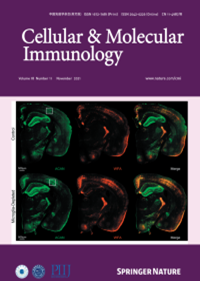γδ T-cell autoresponses to ectopic membrane proteins: a new type of pattern recognition
IF 21.8
1区 医学
Q1 IMMUNOLOGY
引用次数: 0
Abstract
T-cell receptor (TCR) γδ-expressing cells are conserved lymphocytes of innate immunity involved in first-line defense and immune surveillance. TCRγδ recognizes protein/nonprotein ligands without the help of the major histocompatibility complex (MHC), especially via direct binding to protein ligands, which is dependent primarily on the δ chain complementary determining region 3 (CDR3δ). However, the mechanism of protein‒antigen recognition by human γδ TCRs remains poorly defined. We hypothesize that γδ TCRs recognize self-proteins expressed ectopically on the cell membrane that are derived from intracellular components under stress. Here, we mapped 16 intercellular self-proteins among 21,000 proteins with a huProteinChip as putative ligands for Vδ1/Vδ2 TCRs, 13 for Vδ1 TCRs and 3 for Vδ2 TCRs. Functional tests confirmed that ectopic nucleolin (NCL) is a ligand for the Vδ1 TCR, whereas protein-glutamine γ-glutamyltransferase K (TGM1) is a ligand for the Vδ2 TCR. In the context of radiation exposure, the ectopic expression of intracellular proteins on the tumor cell surface is related to the increased antitumor cytotoxicity of γδ T cells both in vitro and in vivo. In conclusion, the recognition of intracellular proteins that are ectopically expressed on somatic cells by human γδ TCRs is a basic interaction mechanism that enables new types of immune pattern recognition and a novel γδ TCR-ligand-based strategy for tumor immunotherapy.

γδ t细胞对异位膜蛋白的自身反应:一种新的模式识别。
t细胞受体(TCR) γδ表达细胞是先天性免疫的保守淋巴细胞,参与一线防御和免疫监视。TCRγδ在没有主要组织相容性复合体(MHC)的帮助下识别蛋白质/非蛋白质配体,特别是通过直接结合蛋白质配体,这主要依赖于δ链互补决定区3 (CDR3δ)。然而,人类γδ tcr的蛋白-抗原识别机制仍不清楚。我们假设γδ TCRs可以识别细胞膜上异位表达的来自于应激下细胞内成分的自身蛋白。在这里,我们用huProteinChip在21,000种蛋白质中绘制了16种细胞间自蛋白,作为Vδ1/Vδ2 tcr的推定配体,13种用于Vδ1 tcr, 3种用于Vδ2 tcr。功能试验证实异位核蛋白(NCL)是Vδ1 TCR的配体,而蛋白-谷氨酰胺γ-谷氨酰转移酶K (TGM1)是Vδ2 TCR的配体。在辐射暴露的背景下,肿瘤细胞表面细胞内蛋白的异位表达与体外和体内γδ T细胞抗肿瘤细胞毒性的增强有关。综上所述,人γδ tcr对体细胞外表达的细胞内蛋白的识别是一种基本的相互作用机制,可以实现新型的免疫模式识别和基于γδ tcr配体的肿瘤免疫治疗新策略。
本文章由计算机程序翻译,如有差异,请以英文原文为准。
求助全文
约1分钟内获得全文
求助全文
来源期刊
CiteScore
31.20
自引率
1.20%
发文量
903
审稿时长
1 months
期刊介绍:
Cellular & Molecular Immunology, a monthly journal from the Chinese Society of Immunology and the University of Science and Technology of China, serves as a comprehensive platform covering both basic immunology research and clinical applications. The journal publishes a variety of article types, including Articles, Review Articles, Mini Reviews, and Short Communications, focusing on diverse aspects of cellular and molecular immunology.

 求助内容:
求助内容: 应助结果提醒方式:
应助结果提醒方式:


